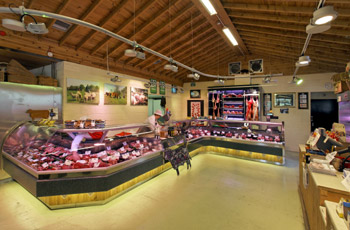Finding new solutions

A number of common threads endure in shopfitting this year but naturally economics has become a major factor, hence the growing lean towards efficiency
14 September 2009
A modern, welcoming retail premises remains crucial for attracting customers into a store, however other considerations have moved to the fore of retailers’ minds over the past year or so.
Energy efficient equipment to save on electricity and reduce emissions in advance of a possible carbon tax in the next budget; solutions that get the most from existing equipment and space; and optimised, appropriate lighting are but a few examples of what’s happening in-store.
CEO of Storefit Shopfitters, Eamonn Brien says that even though finances may be tighter this year, retailers still need, and want, to invest in their stores, especially in things that will add to the bottom line in this particularly difficult environment.
"From an innovation point of view, one of the things that is very popular right now and which is proven to increase sales is a queue management system."
An effective system incorporates barriers for controlling and efficiently disposing of queues as well as optimally positioned impulse displays; this could include anything from confectionery and newsstand to value offers, which most retailers are keen to emphasise these days. The increased popularity of queuing solutions like Storefit’s is a reflection of retailers’ heightened need right now to maximise all shopping trips.
Padraig Nolan, head of sales for Storefit, adds: "We are now installing queuing systems in many convenience stores that have the combined effect of providing more selling space whilst organising the queues to the cash counters in a more efficient manner at the busiest times of the day. This creates a win-win situation for the retailer."
According to anecdotal evidence, Nolan says these solutions can lead to sales increases of up to 30% for retailers after new installations. "This might occur in a store where there has been no gain in shop floor space so one can only conclude that any increase is down to the redesign of the premises."
Practical adjustments
Storefit also advises retailers on innovative yet practical adjustments they can make to their displays, keeping the store looking fresh while also helping to increase sales. For example, switching to upright ‘stadium’ style confectionery units as opposed to flat counter top displays is a worthy investment. Once the product is in the right place, displayed correctly and free of clutter it is then "in danger of being sold," says Nolan.
However, while keeping the store looking good and generating maximum revenue remains a top priority for retailers, so too is minimising costs at present. Therefore, for any retailers looking to make improvements this year, "utilising existing equipment and refreshing rather than refitting" is the answer, says Storefit’s Eamonn Brien.
While ambient shelving, counters and displays are Storefit’s specific area, Brien says he is aware of other layout trends at the minute, in particular the reduction of space and resources allocated to the hot and cold deli. In tandem with this trend, increased floor space is being allotted to stores’ special offers and value ranges. With regard to using the layout to message shoppers about the store’s proposition, emphasis is very much being placed on creating a perception of value within the store.
"People are introducing more value lines because it’s much more competitive out there, using, for example, gondola-end shelving to promote these lines; the impact it has for the customer coming in is to create the impression that this store offers good value for money."
Storefit advises customers on how to utilise their space, equipment and displays to best effect, whether to promote their ‘wow’ offers or drive a particular value range, and ultimately, to create the perception of value in-store.
Within the use of aisle ends, the types of displays and even promotions have changed along with consumer needs this year. Says Brien: "Previously, the prominent aisle ends would have been devoted to impulse lines, which would have been popular in better economic times." Or indeed up until more recently when promoting on impulse products was still the dominant constituent of some convenience retailers’ offering.
This has changed however. Retailers are now stressing the importance of core grocery and household ranges as key components of the value offering and special offers, which often means larger, bulkier displays that have to be managed in prominent positions in the store.
Unique designs on budget
For Storefit, whose ethos purports that a layout solution should always enhance the store’s visual appeal, even if the function is to promote the idea of value for money, consultation on these kinds of displays always takes account of the store’s brand proposition and keeping things contemporary.
"Our challenge is to tailor the design for each individual client," says Padraig Nolan, and Brien affirms that creating an effective display in any shop is very much dependent on the nature of the individual space being dealt with. Particularly, as he mentioned earlier, when the retailer aims to work more with what exists in the store as opposed to buying in brand new kit.
"Generally, refits are more about consulting with ourselves about what of the existing equipment can be used satisfactorily in a refresh of the store," says Brien, thereby keeping costs to a minimum while optimising all opportunities to enhance the store’s selling power and refresh its look. Storefit designers consult with customers about what objectives they want to achieve, then work with the store to "keep the end budget as low as possible to attain the end result."
Individualised solutions
In general however, Storefit is still seeing demand for cutting edge, contemporary interiors, for which an element of individuality is a must for any store. "The overall design needs to have focus points and some bespoke features built in," says Nolan, "you need to break the monotony with regards to the design and give each store its own unique signature."
As Brien pointed out before, every shop is different and every retailer has different objectives they want to achieve, but Nolan asserts however that there are a few essentials that should be considered in each design.
"The atmosphere that is created can not be imposing, with the most important thing being the delivery of a unique shopping experience for the customer that is a natural extension of your brand. We achieve this for the most part by maximising the display space without compromising the customer’s comfort."
Sagely, he adds: "The cost of upgrading needs to be considered but the price of doing nothing needs to be taken into account just as seriously, or it is likely that the competition will drive ahead if you remain stagnant."
A preliminary consultation with Storefit determines what are the goals of the refit or first-time fit-out, and from there the team draws up a design proposal and a budget for the project.
Nolan is quick to add: "And we are able to offer alternative solutions to meet the customer budget," acknowledging the importance of flexibility in the present economic climate.
Shedding light on the subject
Another important component of a store’s artillery is lighting and as with most other things, the experts in the field are currently looking for ways to make the necessary equipment work for less.
Design and technical manager with Baro Lighting, Steve Brough explains: "One of the main driving factors at the minute is energy saving as that is quite a high cost, especially with the fact that, generally, in retail lighting you are lighting to quite a high level."
As a consequence, many businesses are now trying to find ways of incorporating LED lighting which uses considerably less energy. There are issues working with the technology, says Brough, as the lights can’t yet generate sufficient output to adequately light large areas; under-shelf, in-fridge and other applications where the light source is closely off-set against the product are still the predominant space of the LED.
According to Brough, certain major mainstream retailers are currently experimenting with LED lighting "on a large scale" throughout particular stores in Europe. Baro has been involved in trial LED lighting solutions with German retailer Edeka, at a specific site in Düsseldorf: "To be honest, the large aisles and food displays are not lit as we would expect," admits Brough, "but the off-set stuff looks fine."
That said, it is only early days. He adds: "It’s an experiment you’ve got to try and you’ve got to take that step forward. I think we’re not too far away from being able to develop luminaires that can incorporate LED sources and that can do the full job. I think we are moving in the right direction and we will get there."
Achieving the optimum
More to the fore at present according to Brough, stores are using controllable high frequency lamps to ensure optimum level of energy use, and hence increased energy efficiency. Using more efficient lamps holds many benefits for businesses in terms of energy saving and labour savings, and the British government is even promoting that businesses adapt their lighting as such as part of its carbon emission reduction strategy, he notes.
These lamps ensure that the store’s lighting is "running at optimum performance," says Brough. He refers to a new development from Philips, the ‘Elite Lamp,’ which boasts "improved colour reproduction and improved light output." And there are other similar products launching on the market soon, which ultimately offer retailers improved merchandising enhancement and lower operational cost.
"It’s about getting the best out of the existing technology. I would suggest that it’s down to the lamp really and I think that’s what people are aiming for at the minute," he says.
Trying new light sources
Brough has also observed a trend among retailers at the moment to select a single trial store and try out non-conventional lighting solutions, the likes of which may be at home in a different kind of retail environment from a grocery retail outlet.
"Lighting that you might expect from a non-food retail outlet, a bit more focused on the overall appearance and making the lighting more of a feature within the store rather than just being a tool," he explains.
He compares some of the experimental lighting with the kind found in fashion outlets, "where it becomes part of the overall sell…there’s been a few smaller stores that have worked along those lines." These projects are one-off and unique for particular stores, perhaps in keeping with a new concept or the specific location of the store, he suggests.
In general however, retail lighting still uses tried and tested sources most often, although in quite creative applications in some cases, particularly in the convenience sector in the recent past.
For Brough, the most important part is finding the appropriate light source to perform the required task: "You’re looking for the ideal light source most of the time; there’s different variations on the metal halide, and you have the ‘White Sun’ as well. When people are really looking to push the boat out they’ll fine tune the light source to get exactly what they want."
In other words, picking the light source relevant to the individual product on display: "Rather than using a metal halide source throughout the store, you could use it in one area, then use White Sun on the fresh meat counter, and tailor it in that way. That’s something the high-end stores are looking at doing, just to set them apart."
Appropriate lighting for specific sections enhance the consumer’s experience of shopping that category. "Different sources have different properties and they react differently with different products. A White Sun lamp will enhance the colours of fresh foods, and fresh meats, whereas for things like wine you’re looking for a warmer light," explains Brough.
The crucial point, he says is that it’s not the lighting level but the light source that matters in creating the desired effects, and at the optimum cost.
It pays to go green
Lastly but by no means least, there are great opportunities to save money where in-store equipment such as refrigeration units, air conditioning and deli counters are concerned. Specialist REL Group fits out shops from front to back with green solutions linking deli, fridges, air-con, and water heating, leading to significant decreases in the store’s overheads.
At the core of the system is the Hitachi inverter pack, a compact inverter compressor that runs a ring main around the building and has one central refrigerant to which all the different cabinets are connected.
This means that all of the store’s cooling and freezing equipment is run from one central motor on the roof, as opposed to multiple individual compressors, thereby leading to a reduction in running costs by 30 to 40%.
What’s more, the inverter pack allows the compressor to go up and down as energy is required – as opposed to just being either on or off – so it adjusts depending on the energy need of each individual cabinet. A very full cabinet would have greater power needs than one not so heavily stocked. When one has achieved its temperature the pack will only distribute the energy where it is needed at the time.
A great bonus of this smart system, for those that opt for it, is the addition of a heat recovery unit. The device collects heat extracted by the refrigeration system and rather than allowing it to escape, it gathers the majority and diverts it to heat water to approx 40 degrees centigrade.
"We refer to this as the secondary stage of energy efficiency," explains Niall Rhatigan, sales director at REL, "making use of a free resource to reduce costs and save energy."
In addition to these solutions, REL also offers attractively designed, bespoke hot and cold deli counters, once again incorporating energy efficient technology, and running off the same ring main as the refrigeration system.
Similarly, the group’s chill walls, cold counters and even cold rooms are designed with visual aesthetic and energy efficiency as equal priorities, with all linked to the Hitachi inverter pack to provide a complete, integrated, energy efficient refrigeration solution for the entire business.
"We classify ourselves as a one-stop-shop solution for the mechanical retail market. We supply full solutions for the deli…the full compliment of chilled cabinets, freezers, and cold rooms, all of which operate from the single Hitachi inverter pack, and we supply the air conditioning solutions," concludes Rhatigan.



 Print
Print





Fans 0
Followers